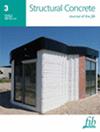用一氧化铅和花岗闪长岩增强混凝土的机械和辐射屏蔽性能:微米和纳米颗粒尺度上的个体效应和协同效应
IF 3.3
3区 工程技术
Q2 CONSTRUCTION & BUILDING TECHNOLOGY
引用次数: 0
摘要
本研究探讨了微纳米氧化铅(PbO)和花岗闪长岩(GD)对混凝土机械性能和辐射屏蔽性能的单独和综合影响。这两种材料以不同的比例部分替代了水泥。此外,还制备了具有最佳辐射屏蔽性能的混合物,以探索两者结合的协同作用。上述材料首次用于纳米尺度的广泛研究,以探讨它们对混凝土机械性能、微观结构和伽马辐射衰减的影响。使用铀(U238)和铯(Cs137)两种伽马射线源测量了所有设计混凝土混合物的辐射衰减系数。利用提供两种读取模式的便携式手持伽马射线光谱仪,采用一种简单的方法来评估混凝土防护罩的效率。结果表明,氧化铅比例的增加与混凝土的辐射衰减能力成正比,其中微粒和纳米粒径的最佳单个替代比例为 5%。在这一比例下,纳米和微型氧化铅的线性衰减系数(μ)值分别提高了 39.57% 和 24.78%。此外,纳米氧化铅和微量氧化铅改善机械性能的最佳比率分别为 3% 和 2%,而比率越高,机械性能越差,尤其是 5% 的微量氧化铅,抗压强度值降低了 7.02%。至于 GD 粉,在纳米和微米尺度上,提高混凝土辐射屏蔽性能的最佳替代比率与提高其机械性能的最佳替代比率一致,分别为 4% 和 7%。组合混合物进一步提高了混凝土的整体性能,尤其是辐射屏蔽能力。与对照组相比,5% 纳米 PbO + 4% 纳米 GD 最佳混合物的抗压强度、抗拉强度和 μ 分别提高了 25.7%、16.2% 和 44.7%。本文章由计算机程序翻译,如有差异,请以英文原文为准。
Enhancing mechanical and radiation shielding properties of concrete with lead monoxide and granodiorite: Individual and synergistic effects at micro and nano particle scales
This study investigates the individual and combined effects of micro and nano lead monoxide (PbO) and granodiorite (GD) on concrete's mechanical and radiation shielding properties. Both materials were partially substituted for cement at varying ratios. Additionally, mixtures with optimal radiation shielding performance were prepared to explore the synergy of combining them. The mentioned materials are used for the first time in an extensive study at the nano scale to investigate their impact on concrete's mechanical properties, microstructure, and gamma radiation attenuation. Two gamma ray sources of uranium (U238 ) and cesium (Cs137 ) were used measure the radiation attenuation coefficients for all designed concrete mixes. A simple methodology was followed to assess the concrete shields efficiency via utilizing portable handheld gamma‐ray spectrometer that offers two reading modes. Results indicated that increasing the ratio of PbO is directly proportional to the concrete ability to attenuate radiation, where the optimal individual replacement ratios were recorded at 5% for micro and nano particle sizes. At this ratio, the linear attenuation coefficient (μ ) values were improved by 39.57% and 24.78% for the nano and micro PbO, respectively. Additionally, the optimal ratio for improving mechanical properties was at 3% and 2% for nano and micro PbO, while the higher ratios showed a decline in mechanical properties especially at 5% micro PbO with 7.02% reduction in the compressive strength value. Regarding GD powder, the optimal replacement ratios for improving concrete radiation shielding were consistent with those enhancing its mechanical properties at 4% and 7% in both nano and micro scales, respectively. The combined mixes further enhanced the overall concrete performance, especially its radiation shielding ability. Compared to the control mix, the compressive strength, tensile strength, and μ were increased by 25.7%, 16.2%, and 44.7% at the optimal mixture of 5% nano PbO + 4% nano GD.
求助全文
通过发布文献求助,成功后即可免费获取论文全文。
去求助
来源期刊

Structural Concrete
CONSTRUCTION & BUILDING TECHNOLOGY-ENGINEERING, CIVIL
CiteScore
5.60
自引率
15.60%
发文量
284
审稿时长
3 months
期刊介绍:
Structural Concrete, the official journal of the fib, provides conceptual and procedural guidance in the field of concrete construction, and features peer-reviewed papers, keynote research and industry news covering all aspects of the design, construction, performance in service and demolition of concrete structures.
Main topics:
design, construction, performance in service, conservation (assessment, maintenance, strengthening) and demolition of concrete structures
research about the behaviour of concrete structures
development of design methods
fib Model Code
sustainability of concrete structures.
 求助内容:
求助内容: 应助结果提醒方式:
应助结果提醒方式:


